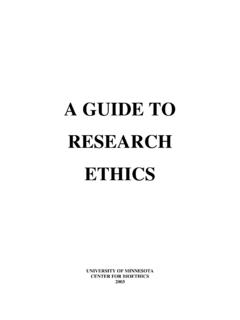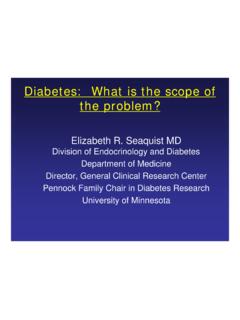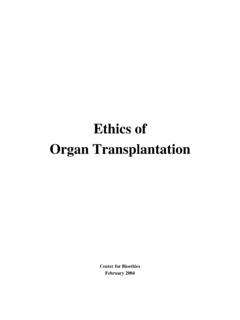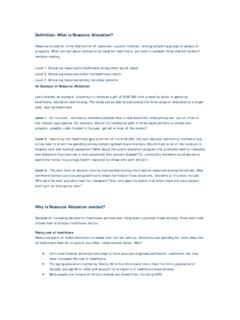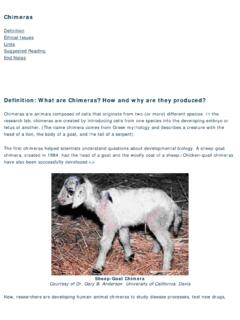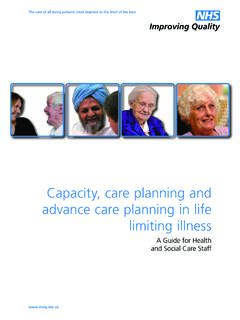Transcription of End of Life Care: An Ethical Overview
1 End of Life care : An Ethical Overview Center for Bioethics University of Minnesota 2005 2 Introduction As medical knowledge and technology increase, so do options for healthcare. When decisions arise concerning the treatment of dying patients, these options present complex Ethical dilemmas. Many are faced with decisions about the best treatment to ease a patient s final suffering. Perhaps a decision will need to be made about whether to allow a patient s life to end by terminating treatment altogether. These decisions regarding their own care or the care of a dying loved one confront people from all walks of life.
2 Beginning with a definition of death in modern society and continuing all the way through post-death issues, End of Life care : An Ethical Overview presents significant Ethical issues related to death and dying . We focus on Ethical considerations of subjects that include the benefits and drawbacks of various types of modern treatment, ending life through physician assistance or termination of treatment, options for preserving the individual autonomy of the patient, the special situation of terminally ill children, and conducting medical research. Each section includes key terminology sufficient to form a basic understanding of the issue and Ethical arguments on both sides of the question.
3 A list of further resources, as well as references throughout the paper, provide quick and easy access to further information on topics of particular interest. With advances in modern medicine, people are living longer, and the number of elderly persons is increasing. As a result, the Ethical issues surrounding end of life care continue to gain importance to all members of society. End of Life care : An Ethical Overview offers a broad introduction to a number of these issues. Both basic and comprehensive, this Overview will provide a starting place for those wishing to explore the complex subject of death and dying for any of a multitude of reasons.
4 3 CONTENTS Introduction 2 Part I What is Death? 4 Causes of Death 5 Defining the End of Life and Declaring Death 7 Non-Heart Beating Organ Donation 10 A Good Death 12 Further Resources 13 Part II Common Approaches to End of Life care 14 Hospice care 15 palliative care 16 Further Resources 19
5 Part III Ethical Challenges in End of Life care 20 Access to care 21 Prognosis 23 Pain Management 24 Withholding and Withdrawing Medical Treatment 25 (Resuscitation, Ventilation, Nutrition and Hydration, Kidney Dialysis and Antibiotic Treatments) Medical Futility 31 Terminal Sedation 33 Advance Directives 34 Further Resources 37 Part IV End of Life Issues: Special Topics 38 Euthanasia and Physician Assisted Suicide 39 Communication: Patients and Healthcare Professionals 45 Children at the End of Life 46 Research with dying Patients 49 Ethical Issues After Death of Patient 50 Homelessness at the End of Life 52 Further Resources 53 Glossary 54 Further Reading 57 References 65 4 Part I What is Death?
6 5 Kochanek, et al. 2002 National Vital Statistics Report, 11 Feb 2004. 52(13). Available on-line at:: WHO DIES? In 2002, million Americans died. 74% of deaths ( million) occurred in individuals who were over 65 years old. 51% of deaths ( million) were caused by either heart disease or cancer. Causes of Death Death often comes with advanced age or serious illness. More than half of all deaths in the United States can be attributed to heart disease and Death is more likely to be violent or sudden in younger people. Causes of death for younger people include:2 Accidents primarily motor vehicle crashes are the leading cause of death for people under age 45.
7 Homicide is the second most common cause of death for ages 15-24 and the sixth leading cause for those 25-44. Suicide is the 3rd leading cause of death for 15-24 year olds and 4th for people ages 25-44. Cancer and heart disease rank 4th and 5th respectively as common causes of death in young people 15-24 years old. They rank 2nd and 3rd in the 25-44 age group. HIV/AIDS is the 5th leading cause of death in people aged 25-44 and the 7th in people ages 15-24. 6 Globally, more than 6 million people die every year. The following were the worldwide leading causes of death in 1998.
8 3 1) Heart disease 6) Diarrhea 2) Stroke and blood vessel blockages 7) Premature births, stillbirths, and neonatal deaths 3) Lower respiratory infections 8) Tuberculosis 4) HIV / AIDS 9) Lung cancer 5) Chronic, obstructive lung disease 10) Motor vehicle crashes 7 Defining the End of Life and Declaring Death Death is the point at which our vital physical functions cease.
9 In past eras, human death was much easier to define than it is now. When our heart or lungs stopped working, we died. Sometimes our brain stopped before our heart and lungs did, sometimes after. But the cessation of these vital organs occurred close together in time. With advances in life support, the line between who is alive and who is dead has become At accident scenes and in hospital rooms, cardiopulmonary resuscitation (CPR) treatments and technologies can re-start and maintain heart and lung functions. Life support technologies introduced in the 20th century have produced a new kind of patient, one whose brain does not function, but whose heart and lungs continue to work.
10 Thus, we need to define death in order to be able to declare a person physically and legally dead. The Uniform Determination of Death Act (UDDA), written by the President s Commission on Bioethics in 1981, confronts the complexities concerning the declaration of death. The President s Commission determined that a uniform death policy would help eliminate confusion and also address problems associated with removing life support and organ donation. Cancer Research UK website Accessed 11/4/03. How Does the Brain Work? The human brain has two main divisions: 1.
